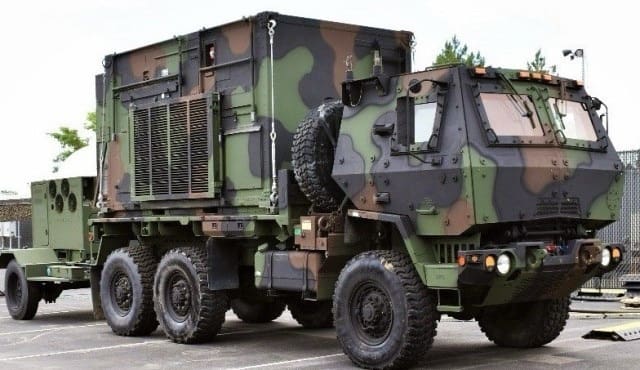ABERDEEN PROVING GROUND, Md. — Field artillery has long been the U.S. military’s long reach battlefield weapon. Because of the big booms and big distance, field artillery has long been dubbed the king of battle. This king is getting a new jewel in its crown that will by way of technology that will bolster its distance capability.
The Tactical Intelligence Targeting Access Node, or TITAN, pre-prototype and the TITAN program of record introduces deep sensing to field artillery. While deep sensing sounds like a drilling term, its real purpose is all about long range sighting. “Deep sensing to me is being able to see over the horizon, no longer limited line of sight. Being able to see on the other side of the mountain or seeing deep into enemy territory would be the deep sensing aspect of that,” said Richard Thompson, Army Tactical Exploitation of National Capabilities, or TENCAP, Ground Station lead.
Thompson is a former U.S. Army chief warrant officer 4 who worked in the field for over 20 years and has seen all sorts of development in the FA world, but nothing like this. “I was in the Army for over 20 years and some of the first systems I used were TENCAP systems. So, the team and I are very passionate about TITAN and we see the importance of the deep sensing and targeting aspect of it.”
TITAN is a big deal to people like Thompson who have worked in the field artillery space for a long time. The value added has everyone excited, because TITAN delivers a next-generation, expeditionary, scalable and maneuverable platform at echelon that is purpose built to address the Army’s number one gap in large-scale combat operations: deep sensing.
By accessing sensor data from multiple sensors simultaneously across the space, high altitude, aerial and terrestrial layers, TITAN provides situational awareness and situational understanding across operations. Fusing that data and using advanced analytics to deliver targetable intelligence to lethal and non-lethal networks reduces the sensor-to-shooter gap and enables long range precision fires, aviation and mission command.
In short, the TITAN pre-prototype is focused on space-based intelligence surveillance and is a reconnaissance asset. As such, the program serves as a critical capability for both the intelligence and fires community.
According to Thompson, their effort with the pre-prototype is meant to deliver space-based functionality to the TITAN program of record that will later be integrated into a single system. This is a major capability increase. “The key is, our peers and near peers are developing weapon systems that can range further. We must be able to find those threat systems and be able to help the fires community and the mission command community engage those systems at range,” said Thompson. “We have to be able to shoot further, but to shoot further you have to find those targets.”
For those who are in field artillery, these are exciting times as the king of battle is poised to be more formidable than ever.
“It comes down to timeliness and accurateness. This TITAN pre-prototype increases the trust of ground force commanders who are relying on extremely accurate data from their Intel personnel and by what we provide,” said CW3 Christopher Trader, Mutli-Domain Task Force TITAN pre-prototype officer in charge.
“That trust elevates tenfold where fires elements can simply receive the data that we provide and then employ the appropriate weapon system to execute. That is, in my interpretation, what big Army is striving for,” Trader added.
Trader is a current user of TITAN pre-prototype and responsible for putting it through its paces to find ways to improve upon its requirements. Deep sensing is a critical asset. Deep visual penetration of the battlefield allows for not only better target acquisition, but better safety and security for all those operating in that battle space. The more personnel you can keep engaged in the fight speaks to the success you can have.
But what about the tried-and-true personnel operating as forward observers? Forward observers have long been the down range eyes of the field artillery. Is there a concern the TITAN program makes them obsolete?
“Absolutely not!” said Trader. “I will stand by that 100 percent, being a previous 96R, which is a ground surveillance system operator in the MI Corps. I know very intimately what and how much of a value [field observers] are, as I was with those guys in the foxholes. The difference is, and I’ll be very blunt, we see past them. We see in distances that they cannot see — so that’s what makes the big difference. We can see beyond the close fight. That is the intent of the TITAN prototype: to get past the close fight and focus on the deep fight,” Trader said.
There are more products on the horizon, some currently in use. The technology surge represents an ever evolving and ever-expanding future. “This is just the beginning. Technology itself is improving every day, whether it’s getting smaller and more robust, or the capability is becoming more user friendly. This is just the beginning,” said Trader.
The Program Executive Office – Intelligence, Electronic Warfare and Sensors is at the forefront of technology and innovation when it comes to enhancing the lethality of Soldiers. While it is true technology is here to stay, the goal now is to find innovative ways to get smart technology into the hands of our warfighters in the most expeditious way possible. The TITAN program of record and pre-prototype are great examples of the U.S. Army leaning in — not just current technology initiatives — but the bright minds, talent and experience to improve upon, field and equip the best Army in the world.
By Ron Lee
This entry was posted
on Tuesday, April 2nd, 2024 at 00:00 and is filed under Army, C5ISR, Guest Post.
You can follow any responses to this entry through the RSS 2.0 feed.
You can skip to the end and leave a response. Pinging is currently not allowed.



